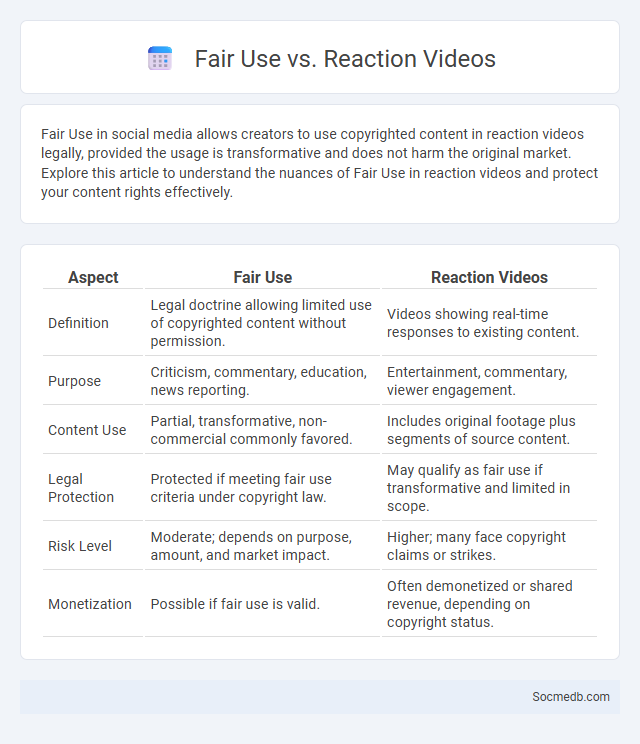
Photo illustration: Fair Use vs Reaction Videos
Fair Use in social media allows creators to use copyrighted content in reaction videos legally, provided the usage is transformative and does not harm the original market. Explore this article to understand the nuances of Fair Use in reaction videos and protect your content rights effectively.
Table of Comparison
| Aspect | Fair Use | Reaction Videos |
|---|---|---|
| Definition | Legal doctrine allowing limited use of copyrighted content without permission. | Videos showing real-time responses to existing content. |
| Purpose | Criticism, commentary, education, news reporting. | Entertainment, commentary, viewer engagement. |
| Content Use | Partial, transformative, non-commercial commonly favored. | Includes original footage plus segments of source content. |
| Legal Protection | Protected if meeting fair use criteria under copyright law. | May qualify as fair use if transformative and limited in scope. |
| Risk Level | Moderate; depends on purpose, amount, and market impact. | Higher; many face copyright claims or strikes. |
| Monetization | Possible if fair use is valid. | Often demonetized or shared revenue, depending on copyright status. |
Introduction to Fair Use and Reaction Videos
Fair Use is a legal doctrine allowing limited use of copyrighted material without permission for purposes such as commentary, criticism, or parody. Reaction videos, popular on platforms like YouTube, often rely on Fair Use to showcase genuine responses to original content while adding transformative value. Understanding Fair Use guidelines is essential for creators to avoid copyright infringement and sustain creative expression in social media.
Defining Fair Use: Legal Framework and Principles
Fair use is a legal doctrine allowing limited use of copyrighted material without permission, crucial for social media content creators navigating intellectual property rights. It balances factors including the purpose of use, nature of the original work, amount used, and effect on the market value, ensuring your posts comply with copyright laws. Understanding these principles helps protect your content from infringement claims while promoting creative expression.
What Are Reaction Videos?
Reaction videos showcase individuals or groups responding emotionally and verbally to a particular piece of content, such as a movie trailer, music video, or viral clip. These videos capture authentic expressions and opinions, offering viewers relatable perspectives and enhancing engagement on platforms like YouTube and TikTok. Your interest in reaction videos helps you connect with diverse audiences while leveraging trending topics to boost your social media presence.
The Intersection: Reaction Videos and Fair Use Claims
Reaction videos on social media platforms like YouTube thrive by engaging audiences through real-time commentary and emotional responses to original content, often sparking debates on copyright boundaries. Fair use claims become central as creators argue that their transformative reactions qualify for protection, balancing content creator rights against freedom of expression. The evolving legal interpretations significantly impact monetization and platform policies, shaping the future of user-generated content ecosystems.
Key Legal Precedents Impacting Reaction Videos
Key legal precedents impacting reaction videos include the landmark case Campbell v. Acuff-Rose Music, which established transformative use as a critical factor in fair use analysis. The ruling emphasized that reaction videos providing commentary or criticism can qualify as fair use, provided they add new expression or meaning. Courts continue to evaluate factors such as the purpose, nature, amount, and effect on market value when determining the legality of reaction content on platforms like YouTube and TikTok.
Common Misconceptions About Fair Use in Digital Media
Many people mistakenly believe fair use allows unlimited use of copyrighted digital media without permission, but it actually depends on factors like purpose, nature, amount, and market effect. You must evaluate whether your use is transformative, non-commercial, and limited to what is necessary to avoid infringement. Understanding these nuances protects your content from legal risks and upholds creators' rights.
Factors Influencing Fair Use in Reaction Content
Factors influencing fair use in reaction content include the purpose and character of the use, such as whether it is transformative or commercial, which impacts copyright considerations on social media platforms. The nature of the original work, the amount of content used relative to the whole, and the potential market effect also play critical roles in determining fair use legitimacy. Social media algorithms and community guidelines further affect how reaction content is shared and evaluated for copyright compliance.
Case Studies: Fair Use Lawsuits Involving Reaction Videos
Several high-profile fair use lawsuits involving reaction videos have shaped legal interpretations of copyright law in social media contexts. Notable cases like Lenz v. Universal Music Group emphasized the importance of considering fair use before issuing takedown requests on platforms such as YouTube. These case studies underscore the evolving balance between content creators' rights and copyright holders' enforcement within digital media ecosystems.
Best Practices for Content Creators and Reactors
Content creators and reactors should prioritize authentic engagement by responding timely to audience interactions and fostering community through meaningful dialogue. Leveraging analytics to tailor content based on demographic insights and platform algorithms enhances reach and viewer retention. Consistent posting schedules combined with diversified content types--such as videos, stories, and polls--maximize visibility and audience growth across major platforms like Instagram, TikTok, and YouTube.
The Future of Fair Use in the Age of Reaction Videos
The future of fair use in social media, especially concerning reaction videos, hinges on evolving copyright laws and platform policies that balance creators' rights with user expression. Algorithms and AI-driven content recognition tools increasingly influence the legitimacy of fair use claims, prompting debates over transformative use and monetization. Legal precedents from cases involving major platforms like YouTube will shape how reaction videos are protected under fair use doctrines in coming years.
 socmedb.com
socmedb.com